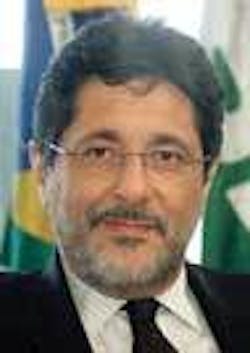Brazil’s $28-billion E&P plan
Eldon Ball • Houston
Exploration and production activities have been defined as a priority in the Petrobras business plan, with $28 billion in capital expenditures allocated in Brazil for the period 2006-2010. So writesJose Sergio Gabrielli de Azevedo, President, Petroleo Brasileiro SA (Petrobras), in the introduction to this month’s special report on Brazil.
Currently, Petrobras has an exploration portfolio of 134 blocks in Brazil, representing a total of 160,700 sq km. Of this, 76% is offshore and 64% in deep or ultra deep waters, he points out. The Campos, Espírito Santo and Santos basins alone account for no less than 41% of Petrobras’ total exploration portfolio area, and all are close to the southeastern consuming market and the country’s leading refineries.
Today, after almost 40 years of offshore activities, offshore production has become vital for Brazil and Petrobras, accounting for about 80% of total production and representing approximately 88% of proved reserves. De Azevedo outlines Petrobras’ E&P plans to introduce this issue’s special section on Brazil, beginning onpage 28.
Trinidad & Tobago going strong
Anyone who was around to observe Trinidad & Tobago’s offshore hydrocarbon exploration activities in 1954 would most likely not recognize the place in 2006. In the past 52 years, E&P activities have shifted from the production of oil from the Soldado field in the shallow water Gulf of Paria to the production of gas from the island country’s huge reservoirs in the Caribbean Sea.
With proven reserves of 990 MMbbl of oil and nearly 26 tcf of gas in 2005, Trinidad & Tobago is by far the largest energy player in the Caribbean. It is therefore no surprise that Trinidad & Tobago’s hydrocarbon industry now plays host to major international oil and service companies from around the world.Technology Editor Ted Moon looks at the Trinidad E&P scene in his special report beginning on page 40.
Continuing rig construction
As of late June, 91 mobile offshore drilling units were under construction or on order worldwide, and another 46 were in shipyards or being readied for upgrades and rebuildings of varying magnitudes. Thirty-six of the rigs under construction or on order have been ordered since the first of the year, and more orders for new rigs are expected. The offshore industry has not seen a construction boom like the current one since the early 1980s.
By type, rigs currently under construction or on order include eight drillships, 57 jackups, 23 semisubmersibles and three tenders. Major upgrades are underway or planned on four drillships, three jackups, eight semis and two tenders, while minor upgrades are underway or planned on five jackups, 12 semis and an arctic rig. To survey the rig construction picture, we askedTom Marsh, vice president, ODS-Petrodata, Inc., to provide an exclusive report to Offshore. His analysis of the market begins on page 42.
Evolution of subsea technology
Industry develops production technology to follow where the explorer leads. In its methodical manner, the oil industry moved from land operations to inland waterways and then to offshore, with surface-piercing platforms in increasing water depths. As water depths of interest began to exceed proven fixed platform technology, or as development costs increased to the point where reserves of interest became uneconomic, the industry started developing subsea well technology as the possible key to deeper water.
The rest, as they say, is history.Offshore recaptures that history is this month’s review of the evolution of subsea technology, authored by Preston Mason, subsea consultant for the Granherne division of Halliburton. His engrossing review of the evolution of subsea technology begins on page 62.


